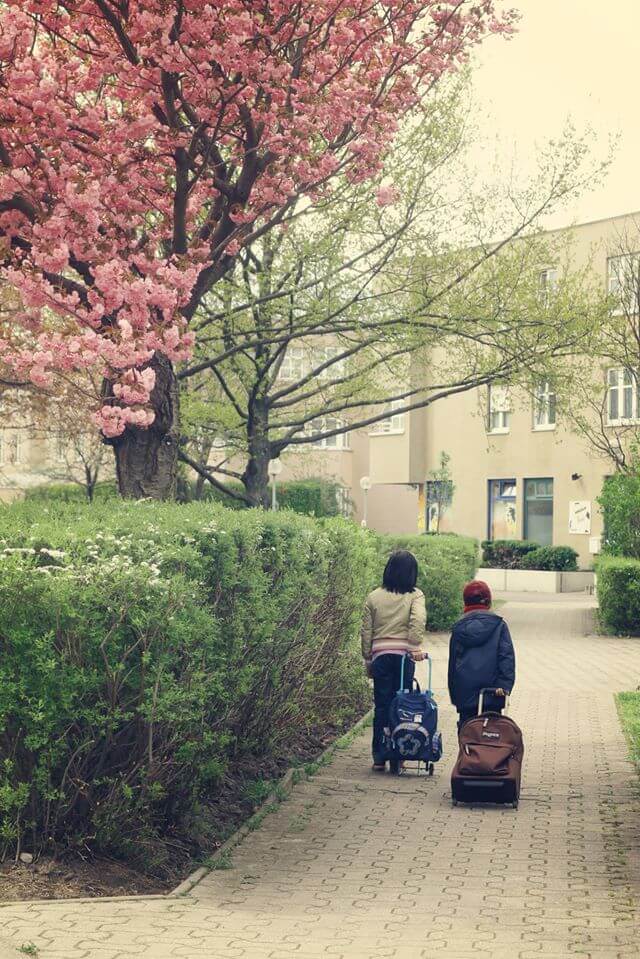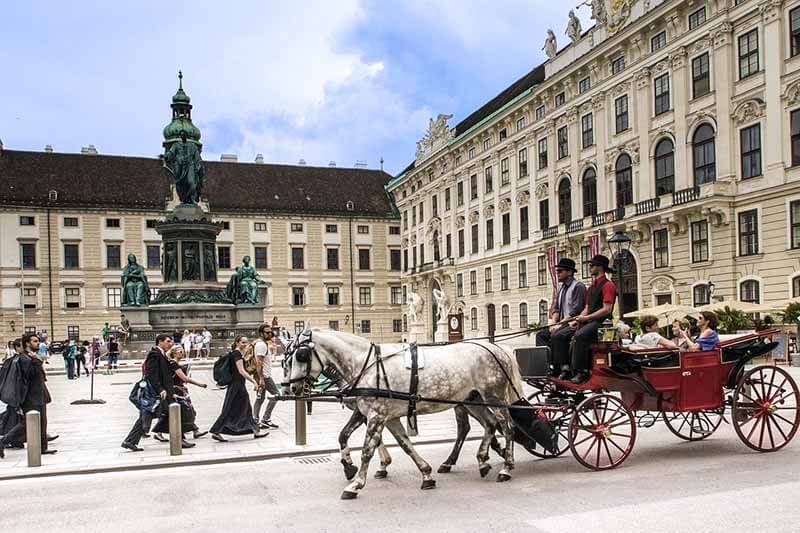
Post updated every time we get to visit Setagaya Park.
A lot about Japan fascinates me, one thing is Hanami or flower viewing. In spring, locals go about admiring the blossoms of cherry and plum trees. With the shortest distance from where I am to Japan being 9,179 km, it’s still on my bucket list to experience first hand (I booked in sometime in 2018 but some circumstances made me cancel).
For now, I visit Vienna’s Setagaya Park, a small Japanese garden in front of a pension house at the 19th district. Cherry trees, magnolias, plum trees, pear trees are some of the flowering trees that make Setagaya park give an authentic Japanese feel.
There’s a small wooden tea house by the lake. I imagine it is used to hold sessions for tea ceremonies, ikebana (art of flower arrangement), and origami (art of folding paper). The lake has a lot of kois, smaller fish, ducks, and tortoises. There’s also a typical Japanese wooden bridge – there’s a small fixture of stones that work as a fountain and at one end of the bridge statues that can typically be found in Japanese gardens.

Setagaya park has become a cheerful extension of home for the residents of the pension house near it. When you visit, you would see a lot of older people walking about doing their own hanami. And because the existence of the blossoms mentioned is fleeting, it is always wise to visit as soon as the first bud appears.
Update 2024 : spring came early this year. We went on March 17 and the magnolias are all in full bloom.
Elements
Japanese gardens are renowned for their serene and harmonious designs, often incorporating elements from nature to create a tranquil and meditative space. While each garden is unique and can vary in size and style, several typical features are commonly found in traditional Japanese gardens:
Natural Materials: Japanese gardens emphasize the use of natural materials like stone, gravel, sand, wood, and water. These materials are carefully arranged to evoke a sense of nature.
Water Elements: Water plays a central role in Japanese gardens, symbolizing life and purity. Ponds, streams, waterfalls, and even dry water features (using gravel or sand to represent water) are often present.
Bridges: Arched bridges, like the iconic arched wooden bridge (taiko-bashi), are frequently featured in Japanese gardens. They are meant to blend harmoniously with the natural surroundings.
Rocks and Stones: Large rocks and stones (known as ishi) are strategically placed to create a sense of balance and mimic natural landscapes like mountains or islands.
Paths and Walkways: Japanese gardens are designed to be explored at a leisurely pace. Curving pathways made of stepping stones or gravel meander through the garden, encouraging visitors to experience different views.
Plant Life: Japanese gardens often showcase a variety of carefully chosen plants, including trees, shrubs, and flowers. The selection of plants is intended to reflect the changing seasons, emphasizing harmony with nature.
Bamboo Elements: Bamboo is a common material used in Japanese gardens for fences, water spouts, and other decorative features.
Tea Houses or Pavilions: Some Japanese gardens include a tea house or pavilion where visitors can participate in traditional tea ceremonies and enjoy the garden’s beauty from a different perspective.

Symbolic Stones and Arrangements: Certain stone arrangements, such as a trio of stones representing heaven, human, and earth, are common in Japanese gardens. These stones hold symbolic meanings and add depth to the garden’s design.
Tsukubai: A tsukubai is a stone basin filled with water, usually placed near a tea house. It is used for ritual handwashing before participating in a tea ceremony, emphasizing purification.
Pruned Trees: Bonsai and other pruned trees are sometimes incorporated into Japanese gardens, showcasing the art of miniature tree cultivation.
Islands and Peninsulas: Larger Japanese gardens may have islands or peninsulas in the middle of ponds, representing mythical lands or extending the sense of exploration.
The philosophy behind Japanese gardens is deeply rooted in the principles of harmony, balance, and simplicity. These gardens seek to create a seamless connection between human beings and nature, providing a space for contemplation and inner peace.

What To Do at Setagaya Park
Setagaya park, and Japanese gardens in general offer a tranquil and immersive experience, providing visitors with a range of activities that promote relaxation, mindfulness, and appreciation for nature. Here are some activities you can do in a Japanese garden:
Strolling and Contemplation: Japanese gardens are designed for leisurely strolls. Take your time to walk along the winding paths, observing the carefully arranged elements, and immerse yourself in the beauty of the surroundings. Use this time for contemplation and mindfulness.
Meditation and Relaxation: Many Japanese gardens are perfect places for meditation. Find a quiet spot, sit comfortably, and focus on your breath or the sounds of nature. The peaceful ambiance of the garden will enhance your meditation experience.
Photography: Capture the beauty of the garden through photography. Japanese gardens offer excellent opportunities for taking stunning photos of landscapes, flora, and traditional architectural features.

Tea Ceremony: Some Japanese gardens, especially those connected to tea houses or pavilions, may offer traditional tea ceremonies. Participating in a tea ceremony is a cultural experience that involves preparing and serving matcha (green tea) in a serene setting.
Drawing or Painting: Bring your sketchbook or easel and capture the essence of the garden through art. Many artists find inspiration in the tranquil landscapes of Japanese gardens.
Reading and Writing: Find a quiet spot to read a book or write in your journal. The calming atmosphere of the garden can be conducive to relaxation and creativity.
Birdwatching: Japanese gardens often attract various bird species. Grab a pair of binoculars and enjoy birdwatching amidst the greenery.
Cherry Blossom Viewing: If the garden contains cherry blossom trees, visiting during the cherry blossom season (typically in spring) is a special experience. The blooming cherry blossoms create a breathtaking sight known as “hanami.”
Picnicking: Some Japanese gardens have designated areas where visitors can have a picnic. Bring a bento box or a packed lunch and enjoy a meal surrounded by nature.
Seasonal Events and Festivals: Some Japanese gardens host seasonal events or festivals, featuring cultural performances, art displays, or flower exhibitions. Check the garden’s schedule for any special events during your visit.
Appreciating Koi Fish: If the garden has a pond, you can enjoy watching the graceful movements of colorful koi fish, which are often an integral part of Japanese garden design.
Remember that Japanese gardens are spaces for relaxation and reflection, so activities that align with the garden’s serene atmosphere are ideal. Respect the tranquility of the environment and follow any guidelines set by the garden management to ensure everyone’s enjoyment of the space.

How To Get To Setagaya Park
Setagaya Park is located at Gallmeyergasse 4, at Vienna’s posh 19th district.
There are several ways to get to the park:
Starting off at Schottentor (U4, U2), take Tram 37 going to Hohe Warte. Get off at Barawitzkagasse and go across the zebra to the Pension home side. This takes about 19 minutes. You can also start off at Nußdorfer Straße (U6) and take the same line.
Coming from Heiligenstadt (U4 and Sbahn), take Bus 10A that’s going to Niederhofstrasse and then get off at Barawitzkagasse/Hohe Warte. Cross the street over to the side of the Pension home. This option takes about 8 minutes from the train station. Bus 10A also passes by several train stations – Meidling Haupstrasse (U4), Schönbrunn (U4), Johnstrasse (U3), and Gersthof (Sbahn), you can get on from these stations as well.
..

--------------------------Book your Vienna stay here!--------------------------




.jpg)






Leave a Reply